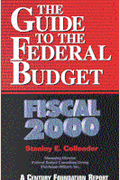Introduction
After decades of deficits, the recent emergence of federal budget surpluses and the expectation of even larger surpluses over the next decade or more have dramatically altered debates regarding tax and spending policy. The most recent Congressional Budget Office estimates, released in July 1999, project a unified budget surplus of $ 2.9 trillion for 2000-2009. This is divided between off-budget (social security) surpluses of $ 1.9 trillion and on-budget surpluses of $ 1 trillion.
Choices concerning how to allocate these surpluses will shape fiscal policy for years to come, just as persistent deficits dominated fiscal choices in the 1980s and early 1990s. In practice, leaders of both political parties agree that the accruing surpluses in social security should be used to shore up the program’s long-term financial status. The real debate is currently focused on how to allocate the remaining trillion dollars in on-budget surpluses among tax cuts, government spending, and debt repayment.
In an earlier study (Auerbach and Gale 1999), we examined these issues based on CBO’s January 1999 forecast and reached several main conclusions. First, the on-budget surplus—at that time estimated at $ 787 billion over 10 years—was based on at least two tenuous assumptions. Real discretionary spending was assumed to be reduced by more than $ 600 billion during the next decade, which seems unlikely for political reasons. And, more than 84 percent of the surge in income tax revenues relative to GDP from 1994 to 1999 was assumed to be permanent.
In addition, more than $ 400 billion of the projected on-budget surplus was due to accumulations in trust funds for Medicare and military and civilian pensions. Like social security, these accumulations represent future promises made to current workers and show up as government surpluses only because government books report cash flow rather than accruals. Thus, the general agreement that social security funds should not finance tax cuts also implies that government pension and Medicare trust fund accumulations should not be used for tax cuts.
In short, plausible adjustments of discretionary spending and tax revenue projections, and preservation of government pensions and health reserves would more than eliminate any surplus available for tax cuts over the next 10 years.
Second, despite surpluses in the near future, the long-term forecast showed significant deficits—even if the entire surplus were saved—due to rising costs of Medicare and social security. The Congressional Budget Office estimated that an immediate and permanent tax increase or spending reduction of about 0.6 percent of GDP would be required to maintain the same debt/GDP ratio in 2070 as exists currently. These estimates, however, understate the problem because the government in 2070 would be running large deficits. Using a methodology developed by Auerbach (1994, 1997), we found that a permanent tax increase or spending cut of 1.5 percent of GDP would be required to bring the steady-state debt/GDP ratio into line with the current value. Tax cuts would significantly exacerbate the long-term shortfalls. Under the CBO methodology, a 10-percent cut in income tax rates would raise the fiscal gap would rise to 2.2 percent of GDP through 2070. Under our estimates, the permanent fiscal gap would rise to 2.5 percent of GDP. Thus, the long-term budgetary situation provided no justification for a significant tax cut.
Third, although aggregate federal tax revenues in 1999 were the highest relative to GDP in over 50 years, families at most points of the income distribution were paying less in federal taxes in 1999 than they would have with similar real income in most of the past 20 to 30 years. The reconciliation of these two trends is that, among the highest-income taxpayers, average tax rates have risen slightly and income levels have risen dramatically in recent years.
Finally, a tax cut would do little economic good in the current, booming economy. The Federal Reserve has recently taken an aggressive stance against inflation and could be expected to offset any boom in aggregate demand created by tax cuts.
For all of these reasons, we concluded that the combination of a strong economy, relatively low tax burdens on most households, and short-term surpluses could be best used to address the large and deepening fiscal problems related to social security and medicare. If an on-budget surplus arose after those problems had been resolved, then it would be appropriate to discuss whether the funds should be used for tax cuts, spending increases, or further debt repayments.
In this report, we re-examine the issue of how to use the on- budget surplus, updating our previous study in light of CBO’s July 1999 estimates of the budget surplus, the recent $ 792 billion, 10- year tax package that passed the House and Senate earlier this summer, and the details of the president’s plan released this past spring. In section II, we examine differences in the 10-year budget forecasts made in January and July 1999. In section III, we re- examine the role of the assumed decline in real discretionary spending, the assumed permanence of the revenue surge, and the role of trust fund accumulations in generating the on-budget surplus over the next decade. In section IV, we compare the plans put forth by Congress and the administration and examine their budget impacts over the next 10 years. In section V, we estimate the long-term effects of the plans on the budget. Our final section offers some brief conclusions.
We find that the budget forecasts changed by relatively small amounts from January to July 1999, and that most of the impact of the changes is short-term. The underlying long-term fiscal imbalance is reduced only slightly. Over the next 10 years, the congressional tax cut plan would reduce the surplus by more than the administration plan, but the administration plan would spend more resources early in the budget period, before surpluses grow. In the long term, both plans would exacerbate current estimated shortfalls by sizable amounts, with the congressional tax cut plan creating a somewhat larger imbalance than the administration’s plan.








Commentary
Does the Budget Surplus Justify Big Tax Cuts?: Updates and Extensions
October 18, 1999